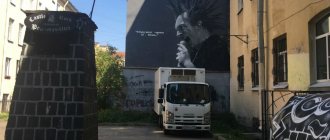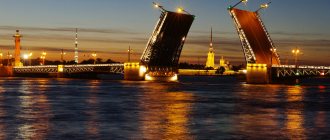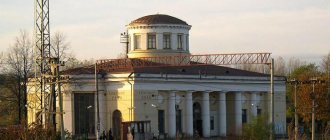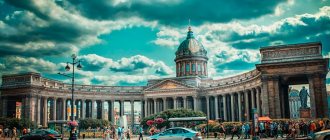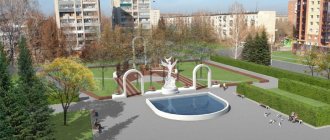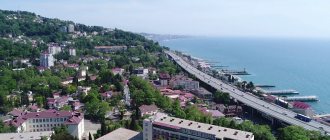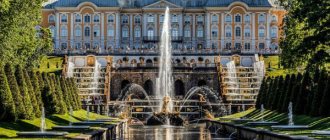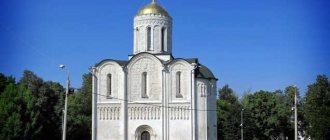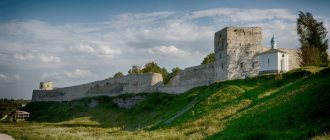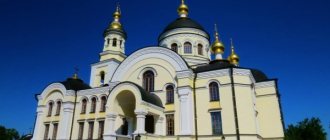In this overview post, we have collected detailed data about the districts of St. Petersburg. You don’t need to Google anything or search on our website yourself - everything has already been done for you: all the most current data has been collected, numbers have been checked, reviews and answers to frequently asked questions have been re-read and summarized. Everything you would like to know about the topic can be found in this post.
Important: we regularly update the information - as soon as something new appears about the districts of St. Petersburg, we immediately add it here. This way you will be aware of the latest news from TravelAsk!
St. Petersburg is a popular tourist city
Districts of St. Petersburg
St. Petersburg is a large city located on the Neva. Its area is 1439 km². 5 million people live here, St. Petersburg ranks second in Russia in terms of population, more people live only in Moscow. Therefore, it is not surprising that St. Petersburg is divided into 18 districts.
18 districts of St. Petersburg on the map
Vyborg
Vyborg is a city with the only medieval castle in Russia (Vyborg Castle). Many films have been and continue to be filmed here. And this is not surprising, because Vyborg combines modern realities and ancient history. While exploring the surrounding area, you should definitely visit the Monrepos rocky landscape park and taste the famous sweet in these places - the Vyborg pretzel.
Due to the fact that the territory of the Vyborg Bay once belonged at different times to the Novgorod principality, then to Sweden, later to Finland, and then again to Russia, Vyborg presents an incredibly harmonious mixture of cultures.
Vyborg district
This is one of the largest districts of the city, the territory size is 115.4 km², the population is almost 500,000 people. The area is located on the right bank of the Neva, in the central part of the city. Divided into two parts - residential and industrial. The environmental situation leaves much to be desired - there are a lot of emissions from different enterprises. But the authorities are trying to compensate for the pollution - they are organizing green areas, public gardens, and parks.
The area is relatively young, there are no problems with infrastructure - there are many shops, shopping centers, schools, kindergartens, hospitals.
Modern business centers and office buildings have been built.
Transport accessibility is provided by 6 metro stations and highways. Lots of public transport stops.
The real estate is represented by old houses, Khrushchev-era buildings in the center and elite residential areas, new buildings in the outlying areas.
Admiralteysky district
This is the historical center of the city, located on the left bank of the Neva. About 160,000 people live on an area of 13.82 km². This is the smallest district of St. Petersburg and one of the most popular among tourists. Many attractions of St. Petersburg are located here:
- Saint Isaac's Cathedral.
- Bronze Horseman.
- Yusupov Palace.
- Opera and Ballet Theatre.
The main buildings are buildings of the 18th century. Apartments here are expensive, especially those located near the water.
Top view of the Admiralteysky district
However, St. Petersburg residents themselves do not want to live in the Admiralteysky district. There are problems with infrastructure here - there is no space for the construction of large stores, shopping centers, hypermarkets, so you have to go to neighboring districts for shopping.
In addition, most of the residential buildings are dilapidated or in disrepair.
There are few trees here, but there are a lot of cars and public transport, and the air is polluted.
It’s difficult to leave here - there are constant traffic jams. Despite the fact that there are 9 metro stations open in the Admiralteysky district, this is not enough. The subway cars are filled to capacity, creating a crush during rush hour.
Day three
Peterhof - joyful mood
Photo: Vasilisa Tarunova
Today, the unique museum-reserve, which is called the capital of fountains, includes 150 water bodies, several palaces and other buildings. This is a real engineering miracle of the 18th century. In an ideal park with golden palace towers, wide alleys and neatly trimmed trees, even the Gulf of Finland does not look so harsh.
Music for a walk : Antonio Vivaldi.
Time to explore without the palace: at least 3 hours.
Ticket price: to the park - 400 rubles for Russian citizens*. Palaces - additionally.
How to get from St. Petersburg: from the Baltic station by train to the New Peterhof station (about 45 minutes), then by buses 344, 348, 350, 351, 352, 355, 356 (10-15 minutes). From the Avtovo metro station by minibuses 224, 300, 404, 424/424A (about 1 hour). A hydrofoil motor ship will take you to Peterhof from the Senate Pier pier in just 30 minutes.
The journey by car to Peterhof will take an hour.
Vasileostrovsky district
Another central area of St. Petersburg beloved by tourists. It is located on three islands, the total area of which is 21 km². The population is about 200,000 people. Vacationers stay here for the attractions and proximity to the center - you can walk to Nevsky Prospekt.
But the locals don’t like to live here - there are many problems with transport. The islands are connected to the rest of the city by four bridges. Until 2016, during the construction of bridges from the Vasileostrovsky district, it was impossible to go anywhere by land transport. But after the opening of the WHSD section, the situation was resolved, and there were fewer traffic jams.
There are also metro stations built here, but their capacity is not enough; there are always a lot of people in the metro.
But real estate is still expensive. The area is built up with old housing stock, new panel buildings, and elite residential areas.
Vasileostrovsky district is located on three islands
THIS IS INTERESTING. Vasileostrovsky district is one of the oldest in St. Petersburg, it was founded in 1917.
Kalininsky district
It is located in the north of St. Petersburg and covers an area of 40.12 km². About 500,000 inhabitants live here.
The area has a well-developed public transport network, many stops, and several metro stations. Hospitals, kindergartens and schools, a dozen institutes and universities were built.
The area itself is considered industrial; there are factories and other enterprises here. But they are mostly located in the southern part of the district, the northern territories are occupied by public gardens, parks and forests.
A large number of crimes are recorded in the Kalininsky district, so it is better to be careful here at night.
Active development of the territory is underway, with new residential areas being built every year. Real estate prices depend on the location of the house - the closer to the north, the more expensive.
Pushkin (Tsarskoye Selo)
This city is famous not only for its parks and palaces, but also, of course, for the Tsarskoye Selo Lyceum, where A.S. studied. Pushkin. While in Pushkin, you should first of all visit the Great Catherine Palace with the famous Amber Room.
Architecture connoisseurs will definitely enjoy the sophistication of Russian Baroque. Tired of the decoration of the palace, you can leisurely walk through the Catherine Park, feed the ducks swimming in the large pond that divides the park into the Old Garden and the English Park with magnificent landscapes. While walking through the Alexander Park, be sure to stop by the Chinese Village and visit the Palace of Alexander I.
Kirovsky district
Over 300,000 people live here on an area of 48 km². The area has a favorable location in the north-west of St. Petersburg - on the shores of the Gulf of Finland. However, the entire shore is occupied by industrial enterprises, so you won’t be able to live with a view of the water. There is a poor environmental situation here, heavy gas pollution, dirty water. The area is one of the dirtiest areas in the city.
Transport accessibility is not satisfactory:
- 5 metro stations;
- Railway;
- several wide highways.
The housing stock is heterogeneous - there are both old dilapidated houses and modern buildings. Apartments in the Kirovsky district are cheaper than in neighboring districts, since it is considered an industrial zone.
The infrastructure is developed. There are many shops, canteens and cafes, dozens of educational institutions, including several private schools.
Tourists rarely come here, but there are a couple of interesting monuments and memorials. For example, the Narva Triumphal Gate.
The main attraction of the Kirov region is the Narva Triumphal Gate
Kolpinsky district
This is one of the largest districts of St. Petersburg. Its area is 105.8 km². However, less than 200,000 people live in such a large area. This is a suburb of St. Petersburg. There are no metro stations and the public transport network is poorly developed. Despite the fact that the M-10 federal highway passes through the area, traffic jams are almost constant here.
The environment is bad. This is an industrial zone where there are about 30 large enterprises. At first, houses in the Kolpino region were built for factory employees. Then little-known construction companies came here, some of which turned out to be scammers. But recently, modern new buildings have begun to appear in the area, and apartments are actively being sold. Real estate is cheap. St. Petersburg residents do not want to move here, although the social infrastructure here is quite well developed.
Peterhof
Looking for what to see in the suburbs of St. Petersburg? Be sure to visit Peterhof! For two centuries, the summer residence of emperors was located here. Primorsky Paradise is a grandiose triumphal monument that glorifies the greatness of the Russian Empire, which gained access to the Baltic Sea after the victory in the Northern War. Fountain complexes, luxury of palaces, splendor of interior decorations - all this creates a special atmosphere of the grandeur of Peterhof.
Krasnogvardeisky district
Located in the north-west of the city on the right bank of the Neva. Its area is 56.83 km², the number of inhabitants is about 350,000 people. This is another industrial outlying area of St. Petersburg with poor ecology. There are about 50 industrial enterprises on its territory.
There are problems with public transport; getting to the city center during rush hour is problematic, despite the fact that two metro stations have been built here, and there are trolleybuses and trams.
The infrastructure is developed - many schools and technical colleges, shops, shopping centers. Museums, theaters, and libraries are open. There are few trees, there are practically no squares and parks - only the Rzhevsky Forest Park. But it is unkempt, and walking there in the evening can be dangerous.
Real estate is cheap. The housing stock is mainly represented by Stalinist and Khrushchev buildings, although new houses are still being built.
THIS IS INTERESTING. The first street art museum was opened in the Krasnogvardeisky district. It is located in an existing industrial enterprise.
Krasnoselsky district
This residential area of St. Petersburg is considered the most environmentally friendly place in the city. There are practically no enterprises here, but there are many parks, squares, and forests. The territory is significant - 115 km². A little more than 400,000 St. Petersburg residents live here. A significant part of the area is occupied by settlements and the private sector, with many cottages.
The infrastructure is well developed - there are shops, medical facilities, kindergartens and schools.
Real estate is inexpensive, houses are mostly budget, but not always of high quality. However, active development of high-rise business-class buildings is underway. The transport problem is acute - there is not a single metro station here, and there is not enough public ground transport for all residents, and traffic jams often occur. It takes more than an hour to drive to the city center. By 2023, it is planned to open the Yugo-Zapadnaya metro station, which should improve the situation.
The most environmentally friendly district of St. Petersburg is Krasnoselsky
Detailed map of St. Petersburg and the Leningrad region with streets and house numbers, districts
A schematic and satellite detailed map of the city of St. Petersburg with streets and house numbers, attractions, districts, makes it easy to search for addresses and routes in real time with high detail.
The maps have the ability to online calculate distances between two objects, search for an address and zoom, switch to satellite mode and panoramas in real time. The map of St. Petersburg is free, does not require downloading or installation. New buildings and residential complexes. Lenta, Ikea, Maxidom and Mega stores. Gazpromneft and Lukoil gas stations, pharmacies, attractions and understand how to get to them. The map of the Leningrad region shows metro stations, theaters, parks, hotels, museums, shops, cinemas, and Russian post offices. On the map, the most frequently searched for are Bukharestskaya, Sofiiskaya and Korolevskaya streets, Komendantsky, Leninsky, Ligovsky, Bolshevikov, Grazhdansky and Veteranov avenues, Vasilyevsky and Krestovsky islands, Pionerskaya, Vosstaniya and Sennaya squares. Now 2 GIS and Google applications are not needed, all current data is pulled from the people's map of Russia. On the map you can find Aspen Grove, Ice Palace, Yachtny Bridge, Shushary village, Alexander Park, Krasnoe village. Toll road (WHSD, Western High-Speed Diameter), Ring Road (Ring Road), M11 highway to Moscow. Districts of the city: Kronstadt, Primorsky, Moscow, Nevsky, Petrogradsky, Petrodvortsovy, Vyborgsky, Kalininsky, Admiralteysky, Kolpinsky, Krasnogvardeysky, Lomonosovsky, Pavlovsky, Kirovsky, Central, Pushkinsky, Frunzensky, Vasileostrovsky, Krasnoselsky and Kurortny.
Background information about St. Petersburg
| St. Petersburg Square | 1,439 km |
| Population of St. Petersburg | 5,383,968 people |
| City indexes | 190000—199406 |
| Telephone code | +7 812 |
| Vehicle code | 78, 98, 178, 198 |
| OKATO code | 40 |
Toll-free emergency phone numbers to call from your mobile phone
we hope you never need them
- 101— Call the fire department or the Ministry of Emergency Situations
- 102— Call the police
- 103— Call emergency medical services
- 104 — Call the gas emergency service
- 112 — one of the emergency phones used in the GSM standard (The call is available even if the phone keypad is locked or there is no SIM card)
Addresses and contacts of railway stations
+7 unified information service "Russian Railways" Baltiysky , address emb. Obvodny Canal, 120, information office. Vitebsky , address Zagorodny Ave., 52, information desk. Ladozhsky , address Zanevsky Ave., 73, information desk. Finnish , address pl. Lenina, 6, information office. Moskovsky , address pl. Vosstaniya, 2, information office.
Addresses and contacts of bus stations
Central Embankment Obvodny Kanal, 36, telephone
Northern Pl. Privokzalnaya (Murino), phone
Airport addresses and contacts
Pulkovo 1 Address: Pulkovskoe highway, 41. At a distance of 15 km from the city. Information, +7 (812) 337-34-44.
Pulkovo 2 Address: Startovaya, 17. At a distance of 14.5 km from the city. Information +7 (812) 612-05-10.
Levashovo Address: 2 km southwest of the village of Levashovo
Kronstadt district
This smallest district of St. Petersburg (19.35 km²) is of interest to tourists, but not to locals. Just over 40,000 people live here. It is located on the islands in the Gulf of Finland. The only populated area is Kronstadt. It is located on Kotlin Island.
There are problems with both infrastructure and transport - communication with the main part of St. Petersburg is carried out via a dam. There is a lack of shops and entertainment facilities, but several schools and hospitals have been built. There are industrial enterprises.
The historical center of Kronstadt is a UNESCO heritage site. There are many attractions here:
- Naval St. Nicholas Cathedral.
- Summer garden.
- Italian Palace.
Unusual sights
- Gromov's dacha and Lopukhinsky garden
- Lidval apartment building
- "Tear of Socialism"
- Monument to Peter the Great - carpenter
- Courtyard with castle
- Sangal garden
- St. Petersburg Cathedral Mosque
- Major Kovalev's nose
- John Lennon Street
- Datsan Gunzechoiney
Museums
State Hermitage Zoological Museum Museum of Anthropology Museum History of the Political Police of Russia Military Historical Museum of Artillery, Engineering Troops and Signal Corps of the Russian Defense Ministry
Resort area
It occupies a significant area of the coast of the Gulf of Finland - 267 km². However, slightly less than 80,000 St. Petersburg residents live here.
The point is expensive real estate - you can compare the Kurortny district with Moscow Rublyovka. This is a suburb of St. Petersburg with elite cottages. But there is also construction of multi-storey buildings with cheaper apartments.
The infrastructure is at a high level - there are shopping centers, shops, cafes and restaurants, gyms and beauty salons. There are many sanatoriums and health centers. There are good, well-maintained beaches.
The area is very green; 80% of all forest parks in St. Petersburg are located on its territory. This is an ecologically clean place with pine trees.
One of the beaches in the Kurortny district
There is no metro here, but the transport links are good and you can get to the city center without any difficulties. A railway has been laid and high-speed trains are running.
Oranienbaum
Oranienbaum is a unique architectural ensemble located in the suburbs of St. Petersburg. Prince Alexander Menshikov was the first owner of Oranienbaum, after him Peter III, Catherine the Great, and the Dukes of Mecklenburg-Strelitz lived here. The luxury of the Menshikov Palace still amazes the imagination: it was built on a grand scale; some of the interior halls were even superior to Peterhof in their interior decoration!
Under the roof of the palace there is still a belvedere tower, from where Kronstadt can be seen through a spyglass. The Chinese Palace, built by order of Catherine the Great, is a real pearl of Oranienbaum. Almost all park sculptures are original, thanks to which Oranienbaum stands out from all imperial residences.
It is better to visit all of the above places as part of excursions. The guides, with their wealth of information, will help you delve deeper into history. We invite you to our excursions to the suburbs, where you can not only get acquainted with various architectural styles, the way of life, the customs of the imperial families, and plunge into another era, but also get incomparable pleasure from walking through park ensembles.
Moskovsky district
It is located in the south of St. Petersburg, covering an area of 73.05 km. About 350,000 people live here.
The area is green, quiet, quite cozy. Considered prestigious. The housing here is different - expensive elite high-rise buildings, Stalin buildings, Khrushchev buildings, and ordinary new buildings.
Moskovsky district is located near the center of St. Petersburg
The infrastructure is good - shopping centers, concert and exhibition halls, hospitals and clinics, shops. However, due to the active construction of residential buildings and population growth, there is a shortage of kindergartens and schools. But the problem is being solved, new institutions are being built. There are 6 metro stations open, public ground transport runs well.
Industry is also developed here, so in some parts of the region there is an unfavorable environmental situation.
Road transport
The following federal highways pass through St. Petersburg:
- M10 "Russia" to Moscow via Veliky Novgorod and Tver.
- P21 "Kola" to the village of Borisoglebsky, bordering Norway, passing through Petrozavodsk, Murmansk and Pechenga.
- P23 (formerly M20) “Pskov” to the city of Nevel, bordering Belarus, via Pskov and Pustoshka.
- A120 (St. Petersburg southern half-ring, popularly “Betonka”) to Kirovsk, MGU, Gatchina and Bolshaya Izhora.
- A121 “Sortavala” to Sortavala, then adjacent to the P21 “Kola” highway.
- A180 “Narva” to Ivangorod and further to the border with Estonia.
- A181 “Scandinavia” to Vyborg and further to the border with Finland.
- A118 (“KAD”) is a ring road around St. Petersburg.
Nevsky district
Its area is 61.79 km² and over 500,000 people live here. It is located on two banks of the Neva, the buildings are very dense. There are practically no places to build new houses. The housing stock is mainly represented by old houses from the Soviet period. But the government plans to demolish emergency and dilapidated housing to build modern buildings.
Now several new residential areas have been built on the left bank of the Neva overlooking the water and the River Station. Real estate prices here are very high, and the area is considered a prestigious place to live.
There are many shopping facilities, cinemas, restaurants, well-developed social infrastructure - there are sufficient medical and educational institutions.
But there are problems with transport, despite 6 metro stations. The area is connected to the center of St. Petersburg by three drawbridges. Their capacity cannot cope with the large number of cars and public transport, and traffic jams occur.
Is it good to live in the suburbs of St. Petersburg?
The suburbs of St. Petersburg are divided into settlements within the city limits and territorial entities belonging to the Leningrad region. The degree of its development usually depends on which federal subject a specific territory is assigned to (the suburbs belonging to St. Petersburg are better provided with infrastructure), as well as the price of real estate. Let's take a closer look at the advantages and disadvantages of living in different suburbs of the city on the Neva.
Attraction zones Large settlements that are part of St. Petersburg and have the status of “suburban” territories include Pushkin, Pavlovsk, Lomonosov, Petrodvorets, Strelna, Sestroretsk, Zelenogorsk, Kolpino and Kronstadt. Popular regional centers include Vsevolozhsk, Gatchina, Devyatkino and Sertolovo. The real estate market is well developed in such regional towns as Tosno and Nikolskoye.
“The most popular among all the suburbs is Pushkin, not only because it is a palace city with a well-developed infrastructure and beautiful parks, but also because it has the best transport connections with St. Petersburg. This is a very prestigious suburb,” said Dmitry Shchegelsky, president of the St. Petersburg Chamber of Real Estate. Apartments in Tsarskoye Selo are in some cases even more expensive than in a number of districts of St. Petersburg (for example, in Krasnoselsky, Kirovsky, Kolpinsky).
“Housing in Pushkin is most often bought by indigenous residents,” continues Dmitry Shchegelsky. – It is believed that Pushkin residents are one of the greatest patriots of their city in Russia, and they move from one apartment to another only within its borders. Pushkin is also in demand among wealthy St. Petersburg residents who want to move from the city center closer to nature. Apartments on the streets adjacent to the Tsarskoe Selo palace and park ensemble are especially popular among such buyers.”
Another suburb of St. Petersburg, in which purchase and sale transactions on the secondary market are quite active, is Kolpino. “Housing here is cheap, and it is bought by people who do not yet have enough money to purchase an apartment in the city, but they do not want to go far into the region,” explains Irina Romanova, director of the country representative office of the Itaka real estate agency.
“Recently, developers have been actively developing the suburbs of St. Petersburg, especially the Vsevolozhsk region,” states Deputy Director of Consulting Olga Trosheva. – That’s why there have been more and more offers there lately. For example, the share of suburban areas (such as Kudrovo, Vsevolozhsk, Devyatkino, etc.) in the total volume of housing sales in the city and surrounding areas increased over the year from 8.8% to 21.6%.”
From the last century The largest number of new houses (built in the last ten years) are concentrated in Vsevolozhsk and Sestroretsk. The surrounding areas of Peterhof are also beginning to develop, although the main emphasis so far is on business-class cottage communities and luxury real estate near the Konstantinovsky Palace.
In addition, a significant volume of economy and comfort class projects under construction is concentrated in the north, northeast and east of the city, in areas such as Parnas, Devyatkino, Murino and Kudrovo.
“The main advantages of housing under construction in the suburbs is the opportunity to purchase a comfort-class apartment at a fairly reasonable price, which is lower than in similar projects within the borders of St. Petersburg,” notes Olga Trosheva. “Many new projects involve comprehensive improvement of the surrounding area, low-rise residential buildings, their own full-fledged infrastructure and other benefits that even residents of some inhabited microdistricts of “central” St. Petersburg may be deprived of.”
Price spread “In the southern direction (for example, in Gatchina), the cost of apartments is almost two times less than in St. Petersburg,” adds Leonid Sandalov, deputy director of the Bekar real estate agency. – In Kirovsk – about 1.5 times lower. In addition to the low cost of housing, buying real estate in the region gives its owners some other advantages. For example, the transport tax is lower there.”
According to the research and analytics department of the Real Estate Bulletin Group of Companies, the cheapest urban area is Kronstadt, where the average cost per square meter at the end of the year was 68 thousand rubles. It is followed by the Kolpinsky district - 71 thousand rubles. per meter and Petrodvortsovy – 74 thousand rubles. per square.
The most expensive are Kurortny and Pushkinsky districts, where a square meter of living space will cost buyers 78 and 81 thousand rubles. respectively. However, this is also cheaper than in “central” St. Petersburg, where the average cost of a “square” at the end of the year was 87 thousand rubles.
Where is it cheaper? According to the BN database, in Vsevolozhsk for 650 thousand rubles. You can purchase a one-room apartment with an area of 26.6 square meters. m in a two-story wooden house on Griboyedov Street. It takes 50 minutes to get to the nearest metro station (Ladozhskaya) by public transport. In Gatchina, you can buy a one-room apartment (25.7 sq. m) in a wooden house for 780 thousand rubles.
Closer to the city - in the village named after Sverdlov (Vsevolozhsk district of the Leningrad region) - a one-room apartment with an area of 31.8 square meters. m in a brick house can be purchased for 1.43 million rubles. It takes 25 minutes to get to the Lomonosovskaya metro station by public transport.
In Tosno there is a one-room apartment with an area of 32 square meters. m already costs 1.65 million rubles.
Two-room apartments on the secondary market in Sertolovo RUB 2.6 million
In one of the cheapest urban areas - Kolpinsky - one-room apartments cost from 1.7 million rubles. For this money you can buy a house with an area of 30 square meters. m in the house of the 504th series. The cost of real estate in this area of St. Petersburg is influenced, first of all, by the proximity to the Zvezdnaya metro station - it takes 15 minutes to get there by transport.
In Kronstadt, the most affordable one-room apartment can be purchased for 2.3 million rubles. Area – 36.9 sq. m, first floor of a three-story building that has undergone major renovation. Its windows overlook the Gulf of Finland and the base of the Baltic Fleet.
In Lomonosov and Peterhof, apartments also cost from 2.3 million rubles. Comparable prices are also maintained in large cities of the Kurortny district, such as Beloostrov and Sestroretsk.
Prospects at a distance Speaking about the future, experts have no doubt that housing in the suburbs will continue to be in stable demand among buyers. The most popular areas in the coming years will be new development areas, such as Kudrovo and Devyatkino.
Experts also predict that in the coming years, developers will rush “deeper” into the region and remote areas of St. Petersburg, developing more and more new territories and offering buyers even more affordable housing. “If we talk about the most promising urban areas (of those that developers are just beginning to cover), then this is the Kurortny district, which received a new impetus for development thanks to the reclamation project. The Pushkinsky district is also promising, where land of the Agrarian University was recently acquired for development,” comments Olga Trosheva.
Against this background, interest in Soviet-built houses in such “enclaves” as Kronstadt will gradually decline, however, there will always be a buyer for such housing - “settlers” from communal apartments, focused on the cheapest housing, and visitors from other regions of Russia and CIS countries.
Land plots and houses in the Lomonosovsky district: affordable minimum
RBI Holding enters the suburban market
Sale of cottages and plots: natural selection
Inexpensive cottages - the future of the country market
Buy a cottage at a discount: is everything possible in the New Year?
Text: Olga Murashko
Petrogradsky district
It is located on the islands in the Neva delta, its area is 24 km². The population is just under 130,000 people.
It is in this area that the history of St. Petersburg begins - the Petrograd Fortress was founded here. This is the main attraction of the area due to which it is popular among tourists. Many hotels, hotels, and hostels have been built for them.
The area is green, there are many parks and squares. There are prestigious higher education institutions, private gymnasiums and schools, and many kindergartens here. Cafes, restaurants, and canteens are open.
Transport accessibility is not satisfactory; there are 6 metro stations, several drawbridges with wide highways, and public transport is good.
There are problems with real estate - there are few high-quality houses and elite neighborhoods, mostly old dilapidated buildings with communal services. But they are gradually being demolished, building up the territory with modern residential areas, the apartments in which are expensive.
Petrogradsky district is famous for its ancient and unusual buildings
Pavlovsk
Another iconic place for Russia is the city of Pavlovsk. It is here that you have a unique opportunity not only to get acquainted with the interior of the palace in which Emperor Paul I lived with his family, but also to see the original sculptural groups located in the park near the palace.
The furnishings of the palace premises will allow you to plunge into the life of the imperial family, their way of life and customs. Many of the interior items were made by the hands of Empress Maria Feodorovna. The harmonious combination of nature, architecture and the leisurely flow of life in Pavlovsk will allow you not only to have a good time, but also to relax your soul.
Petrodvortsovy district
It stretches along the southern coast of the Gulf of Finland and occupies 109 km². In fact, this is a suburb of St. Petersburg, an environmentally friendly place with a large number of green spaces, parks and squares.
Tourists come here for the sights:
- Peterhof;
- Oranienbaum;
- Konstantinovsky Palace.
Peterhof is the main attraction of the Petrodvortsovy district.
The social infrastructure is well developed - shops, kindergartens, schools, branches of large universities, medical institutions.
Mostly elite cottage communities and low-rise buildings have been built here. The area is prestigious, so real estate is expensive. About 140,000 people live here. The majority of the population has personal transport, which makes it easy to reach the city center along wide highways. There is no metro, but there is a railway, trains and electric trains run regularly. During the tourist season there is a shortage of public transport, and crowding is possible.
Top 10 most interesting attractions in the suburbs of St. Petersburg
The suburbs of St. Petersburg are famous for such settlements as Pushkin, Peterhof, Kronstadt. But before we remember their contribution to history, let's pay attention to slightly lesser-known surroundings that are included in the 10 most interesting attractions.
Duderhof Heights
This is a regional state natural monument, consisting of 3 mountains formed under the influence of a glacier. One of these peaks (Orekhovaya) is the highest peak in the vicinity of St. Petersburg. Its height is 176 m above sea level. The heights have been a nature reserve since 1990. Their territory is included in the UNESCO list of World Heritage Sites.
Shuvalovsky Park
Also on the UNESCO list. A walk along it will allow you to enjoy the landscape and buildings that attract with their beauty and history. These are the Big and Small Palaces, owned by Countess E. A. Vorontsova-Dashkova; the Church of the Holy Apostles Peter and Paul, designed according to the authors' plans in a neo-Gothic style; Adolphe's Crypt - the tomb of Count Adolphe Polier.
Park complex "Bogoslovka Estate"
Ethnographic park of Vsevolozhsk region. Until the end of the 18th century it was called the “Theological Manor”, then it was renamed “Zinovevo”, after the surname of the husband of the owner V. M. Dubyanskaya. At the end of the revolution, the Nevsky Forest Park conservation area was created on the site of the complex.
Since 1960 it has been a national architectural and historical monument.
Visitors to the park will be introduced to the magnificence of the 25-domed Church of the Intercession of the Blessed Virgin Mary, the Chapel of the Savior Not Made by Hands, the bell tower, as well as other buildings of the estate.
Kingisepp
According to historical data, this urban settlement was founded in the 14th century and was originally a defensive fortress of Yam, from which only minor fragments of walls have survived to this day.
In the period from the 18th to the 20th century, the name of the settlement was Yamburg, and from 1952 - Kingisepp, in honor of the Estonian revolutionary V. Kingisepp. The symbol of the city is the Cathedral of the Great Martyr Catherine, in the adjacent territory of which there are medieval stone crosses.
Eliseev Estate
This noble nest goes back to the time of Paul I, who granted these lands to Colonel P. F. Malyutin. The last part of the land was sold. The buyer was advisor Franz Behl. Since 1875, the estate often changed owners until A.G. Eliseev acquired it for his daughter Elizabeth, under whom the main building of the estate, the stone temple of St. Nicholas the Wonderworker was erected and the park was landscaped.
Oredezh caves
Artificial dungeons formed at the beginning of the 20th century as a result of quartz sand mining. There are mentions that the length of the caves reached 15 km. Currently, their length is no more than several hundred meters.
Tourists are fascinated by the Gothic vaults, unusual shapes of caves and the rare colors of sedimentary rocks. Unfortunately, there is a risk of the vault collapsing. Therefore, 2 caves are open for viewing. Winter is considered the safest season to visit.
Tikhvin
A city of ancient Russian architecture, in which there are a large number of monasteries and temples. The main attraction of Tikhvin is the Mother of God Assumption Monastery, erected according to legend by decree of Ivan IV on the site of the appearance of the icon of the Mother of God.
You also cannot help but pay attention to the Cathedral of the Transfiguration, which is located in the central square. It houses the Tikhvin Icon, the miraculous power of which pilgrims talk about. It is definitely worth visiting the historical-memorial and architectural-art museum, located in the cells of the Bogoroditsky Monastery.
In addition to the temple complexes, city guests can take a walk in the Vepsian Forest natural park, see the house-museum of the Russian composer N. A. Rimsky-Korsakov, and get acquainted with the Tikhvin water system.
Hannibal Estate Museum
The museum is located in the village of Suyda, Gatchina district. It was this estate that was owned by A.S. Pushkin’s ancestor, A.P. Hannibal. Here are the original items of the owner. It will be a pleasure to walk through the park, get acquainted with the church in which the poet’s parents got married and visit the monument to his famous nanny.
Gatchina geysers
The Gatchina Geysers are a little-known attraction in the outskirts of St. Petersburg. They represent 6 springs to which the local population gave their names depending on their appearance or characteristics.
Priozersk
The power in the city often changed, which could not but be reflected in the name, monuments reflecting different cultures and temple buildings erected according to the faith of the creators.
The suburbs of St. Petersburg, such as Priozersk, are full of attractions.
At different times the settlement was named: Korela, Kexholm, Käkisalmi.
The main attraction of Priozersk is the Korela fortress, founded in the late 13th – early 14th centuries. The following buildings have survived to this day: the Powder Storehouse, the Old and New Arsenals, and the Round Gate Tower.
During the Russian Empire's possession of the city, the fortress was a prison for especially dangerous political criminals. It contained the family of E. Pugachev, the Decembrists, and the mysterious prisoner “Nameless.”
Primorsky district
It is home to the largest number of St. Petersburg residents - almost 600,000 people. Area - 109 km². There is clean air and good ecology here. There are practically no industrial enterprises, but parks, squares and forests occupy a significant part of the territory.
The area is developing rapidly, new residential complexes are constantly being built. Real estate here is considered prestigious, apartments are expensive. Cottages and townhouses have also been built in the area.
Since many people live here, there is a shortage of kindergartens, schools, hospitals and clinics. However, there are plenty of shops, shopping centers and restaurants. 5 metro stations have been opened, a railway has been built, but the problem with transport accessibility has not yet been solved; there is not enough public transport for all residents. Owners of personal cars also often find themselves stuck in traffic jams, despite the fact that new road junctions and highways were built not so long ago. The area is located behind the railway, so congestion most often occurs behind the crossing.
Pushkinsky district
It is located in the southeast of St. Petersburg, its area is almost 240 km². It ranks second in terms of territory size. About 220,000 people live here.
The area is suburban, located outside the ring road. There are few industries here and there are no environmental problems. There are many parks, squares, green corners. It's quiet, calm, cozy here.
Until recently, there was only prestigious real estate here - old houses near parks, expensive cottages. But now economy-class neighborhoods are being built, the apartments there are quite affordable.
There are several universities, technical schools, many schools and kindergartens.
There is one metro station built here, but most residents and tourists prefer to travel by train. In summer there are often traffic jams due to the large number of vacationers.
People mainly come here to visit Tsarskoye Selo and Pavlovsk.
Tsarskoye Selo is located in the Pushkinsky district
Second day
Gatchina - thoughtful mood
Photo: unsplash.com
There is nothing superfluous in this park: only clear lines and harmony of layout. The Great Gatchina Palace looks like an impregnable bastion. Thick walls, slender towers and a wide parade ground are inscribed in the restrained beauty of northern nature. In a relatively small park there is a unique structure - the Priory Castle, built from compressed clay. The Gatchina Museum-Reserve is included in the UNESCO World Heritage List.
Soundtrack of the walk: P. I. Tchaikovsky.
Time to visit without the palace : about 2 hours.
Ticket price: to the park - free*. Palaces - additionally.
How to get there from St. Petersburg: from the Baltiysky Station by train to the Gatchina-Baltiyskaya station it takes about an hour. In 50 minutes you can get to Gatchina by minibuses K-18, K-18a or by bus 431 from the Moskovskaya metro station.
The journey by car to Gatchina will take about one hour.
Frunze district
This is an area in the east of St. Petersburg, its area is 37 km². The number of inhabitants is about 390,000 people.
One of the oldest districts of the city. Today it is considered dormant, practically not developing. The buildings are dense, mostly panel apartment buildings. There is no new construction. Apartments are inexpensive. The infrastructure is good. Near the metro there are hypermarkets of famous chains, there are cafes, restaurants, beauty salons and gyms.
Universities, technical colleges, schools and preschool institutions were built. There are hospitals.
There are 7 metro stations open, but transport accessibility is still low. There is not enough public transport, there are always traffic jams on the roads, and few exits.
central District
It occupies a small area, only 17 km². Over 200,000 people live here. This is the historical center of the city, most of the buildings were built before 1917. There are many emergency and dilapidated buildings here, but real estate is still expensive. Especially those apartments that are located in the “golden triangle” - between the Neva, Fontanka, Admiralteysky Prospekt and Gorokhovaya Street. Apartments with a view of the Moika River are also highly valued.
Apartments with a view of the Moika in the Central district of St. Petersburg are expensive
The main attractions of the city are concentrated in this area.
- Nevsky Avenue.
- Singer's house.
- Admiralty.
- Kazan Cathedral.
Tourists prefer to stay here, so there are many hostels and mini-hotels located in the houses. There are cafes, canteens, restaurants, grocery stores, and souvenir shops.
Administrative and government buildings were built in the Central region.
11 metro stations are open, buses, trolleybuses, trams, and minibuses operate. Due to ground transport during rush hour, traffic jams form for many hours on the roads.
There are few trees, and the air is heavily polluted due to automobile fumes.

